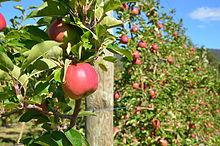Tree Pull Scheme
This article contains weasel words: vague phrasing that often accompanies biased or unverifiable information. (November 2024) |

The Tree Pull Scheme was a government initiative implemented in Tasmania, Australia, during the 1970s aimed at reducing the production of apples, specifically to address an oversupply in the market. The scheme was established in response to significant economic and market pressures on the apple industry, which had once been one of Tasmania's most profitable agricultural sectors. The Tree Pull Scheme was particularly impactful in regions such as the Huon Valley, historically known as the "Apple Valley" of Tasmania.[1]
Background
[edit]
Tasmania became a global apple powerhouse in the 19th and early 20th centuries due to a combination of ideal growing conditions, innovation in agriculture, and favourable trade arrangements. The temperate climate and fertile soil of regions like the Huon Valley and Channel region made Tasmania particularly suitable for apple production. Early settlers planted apple orchards in the 1800s, and by the 1880s, Tasmania had established itself as a major supplier of apples to the British Empire, where the fruit was highly prized.[2]

Tasmania’s reputation for high-quality apples was further enhanced by government-backed export initiatives and improvements in shipping methods, such as refrigerated shipping, which allowed the fruit to reach international markets in prime condition. Known as the "Apple Isle," Tasmania came to dominate Australia’s apple industry, with apples becoming one of its most significant exports.[3] At its peak, the apple industry accounted for around 60% of all Tasmanian agricultural exports, and the United Kingdom was its primary market.[4]
However, in 1973, the United Kingdom joined the European Economic Community, drastically limiting Tasmania’s access to its largest export market. This change, along with rising production costs and increasing global competition, created an economic crisis for the apple industry, leaving local growers with a surplus they could not export.[5]
Implementation
[edit]The Australian Government, in collaboration with the Tasmanian Government, introduced the Tree Pull Scheme as part of a broader strategy to stabilise apple prices and support struggling farmers. Through this program, farmers were offered financial incentives to uproot apple trees and reduce the size of their orchards. The payments provided were intended to help orchardists transition to other forms of agriculture or retire from apple farming altogether.[6] The scheme, which ran between 1972 and 1975, led to the removal of approximately 7 million apple trees and reduced the number of orchardists in Tasmania by around 700.[7]
Impact
[edit]
The Tree Pull Scheme had significant economic, cultural, and social effects on the Tasmanian apple industry and local communities. Once known as the "Apple Isle," Tasmania saw a steep decline in apple production, fundamentally changing the identity and heritage of regions like the Huon Valley that had relied on the apple trade for generations.[8] Many apple varieties, some unique to Tasmania, were lost as orchards were dismantled, and the region’s biodiversity declined.[9]
In addition to reducing apple production, the scheme caused economic hardship for rural communities, leading to declines in employment and local business activity. Some farmers who participated in the Tree Pull Scheme struggled to transition to other industries, while others left farming altogether.[10]
Legacy
[edit]Although the Tree Pull Scheme is often viewed critically for its role in diminishing Tasmania’s apple industry, it also sparked discussions about sustainable agriculture and diversification in Tasmanian farming. In recent years, there has been a revival of interest in heritage apple varieties, and local initiatives aim to promote apple tourism and cider production as alternative economic avenues for the region.[11] Today, Tasmania’s apple industry is smaller but includes niche markets and an emphasis on heritage apple varieties, cider production, and apple-based tourism.
See also
[edit]References
[edit]- ^ "Tree Pull Scheme". The Companion to Tasmanian History. University of Tasmania. Retrieved 5 November 2024.
- ^ "Tasmanian Apples Shipped to England". Australian Food Timeline. Retrieved 5 November 2024.
- ^ "Apple Industry". The Companion to Tasmanian History. University of Tasmania. Retrieved 5 November 2024.
- ^ "The Apple and Pear Industry". Tasmanian Pioneers and Historical Society. Retrieved 5 November 2024.
- ^ "The Demise of Tasmania's Apple Industry". The Friends' School. 5 August 2021. Retrieved 5 November 2024.
- ^ "The Apple and Pear Industry". Tasmanian Pioneers and Historical Society. Retrieved 5 November 2024.
- ^ "A New Apple Future for Tasmania – Any Hope?". Australian Food Sovereignty Alliance. Retrieved 5 November 2024.
- ^ "Australian Apple Varieties and Their Legacy in Tasmania". ABC News. 3 September 2020. Retrieved 5 November 2024.
- ^ "Apples of the Huon - Part Two". Tasmanian Geographic. Retrieved 5 November 2024.
- ^ "Submission to Joint Committee on Public Accounts and Audit". Australian Parliament House. Retrieved 5 November 2024.
- ^ "Apple Isle: The Revival of Tasmania's Apple Heritage". ABC News. 7 May 2022. Retrieved 5 November 2024.
